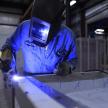What is the WELL Building Standard?
WELL Building Standard® is an evidence-based system for measuring, certifying and monitoring the performance of building features that impact health and well-being.

The first architectural standard of its kind, WELL differs from other building rating tools by focusing exclusively on the health and wellness of people to improve sustainability.
Taking a somewhat holistic approach to the built environment, WELL Building Standard puts the health and wellbeing of people at the heart of building design.
By focusing on the factors we will outline below, WELL Building Standard aims to help businesses provide a healthier work environment for their employees resulting in higher productivity, less sick days and lower staff turnover rates.
How is WELL Building Standard Measured?
WELL has been designed to complement other sustainability rating tools, having considerable overlap of certification requirements. For example it is estimated that 25%–30% of the WELL Building Standard is also considered as part of Green Star.
WELL Building Standard considers 102 features for the WELL certification based on a range of medical studies that give substantial weight to what many designers have always believed.
Many of the WELL features are based on existing Government standards as well as other key industry standards.
The 102 features are summarised into 7 key concepts, all of which are based on medical research concerning how environments affect human health.
- Air
- Water
- Nourishment
- Light
- Fitness
- Comfort
- Mind
WELL Certification is based on performance, with each of the aforementioned key concepts needing a passing score. The Certification is then awarded at either a Platinum, Gold or Silver grading.
Why Consider WELL Building Standard?
Given that people are generally the most expensive resource for a company, it makes sense to ensure they are happy, healthy and therefore productive.
As a general rule we spend 90 per cent of our time indoors, and only 10 per cent outside. And yet we seem to focus so much on the quality of the environment for that smaller margin of our time, while rarely examining the situation we find ourselves in for the larger slice of our day.
As we have discussed, WELL Certified spaces can help create a built environment that improves the health and wellbeing of its occupants. This is achieved through improvement in nutrition, fitness, mood and sleep patterns to name a few.
By offering a healthy work environment companies can also attract the best employees and increase their retention rate, while improving productivity and performance.
WELL certification also demonstrates a leadership mentality and can be a differentiator that attracts top-tier tenants to innovative buildings.
How WELL Building Standard can be Applied
WELL Building Standard can be applied to three types of commercial and institutional projects:
- New and existing buildings – suitable for an owner occupier
- New and existing interiors – suitable for a tenant occupying a portion of a building
- Core and shell – suitable for owners and landlords
QED’s services include inspections, sampling and performance-rating of properties for WELL Building Standard across all 3 project types listed above.
What is a Performance Testing Organization (PTO)?
As a Performance Testing Organisation, or PTO, we serve as a dedicated entity focused on advancing the standards of building performance within the framework of the WELL Building Standard.
Our role as a PTO involves employing comprehensive testing methodologies and advanced tools to collect precise data and insights. We use this information to assist you in creating environments that are not only efficient but also promote well-being and sustainability.
By partnering with QED as a Performance Testing Organisation, you gain access to a wealth of expertise and resources that can help you understand and improve the performance aspects of your building projects in line with the principles of the WELL Building Standard. Our commitment is to contribute to your success by enhancing the quality and wellness of your projects.
What is the Difference between a Performance Testing Organisation (PTO) and a Performance Testing Agent (PTA)?
A WELL Performance Testing Agent is an accredited professional who has successfully completed the WELL Performance Testing Agent training program. They are typically employed by an officially sanctioned WELL Performance Testing Organisation and are authorised to carry out on-site performance testing for projects seeking compliance with either WELL v2 or the WELL v2 pilot program.
More Information
If you would like more information or would like to organise a consultation with one of our team please email us here or call 1300 400 733.
You can also download our free whitepaper for more information on how indoor environment impacts employee performance by clicking the link below.

















